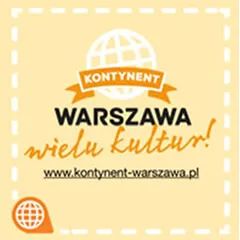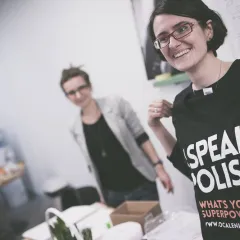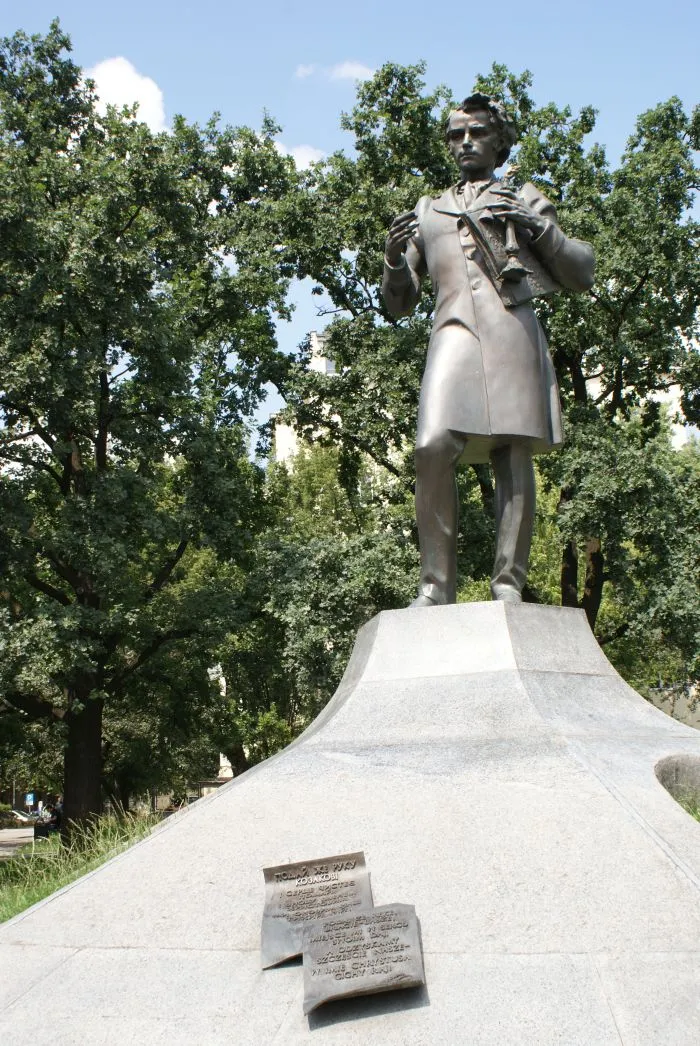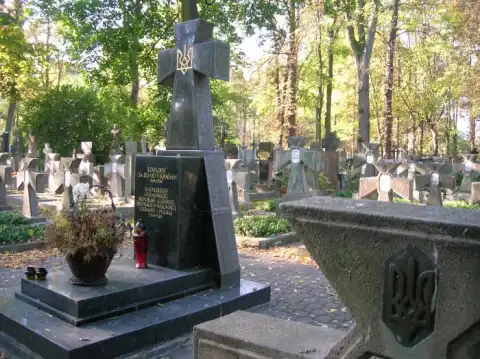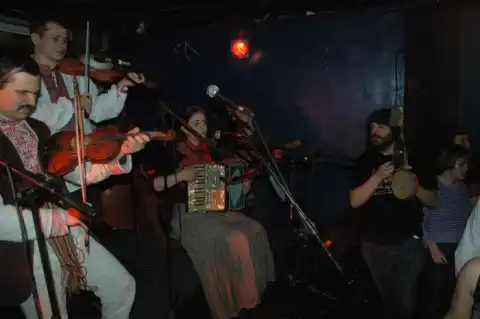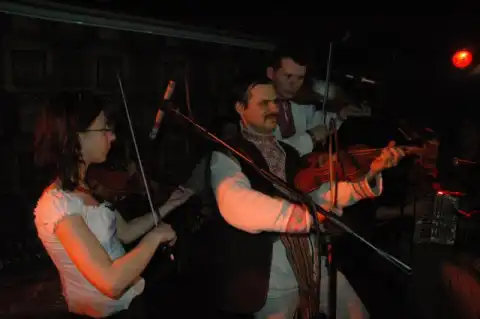They were, they are and they will be
That’s the shortest thing you can say about the Ukrainians in Warsaw, which as each metropolis in the world attracts people looking for new challenges and more interesting life. Due to cultural proximity and relatively close distance from the Dnieper to Warsaw, not only physical workers come here, as it’s commonly thought, but also students, artists, scientists, businessmen, journalists, writers and others. The Eastern face of the city can also be seen in the Greek Catholic Church and the Orthodox Church, as well as in the ethnic Ukrainians dispersed all around Poland as a result of the deportation known as the operation “Wistula”. Media and organizations with a protest in the background
Today the management board of the Association of the Ukrainians in Poland (Związek Ukraińców w Polsce – ZUwP) has its place in Warsaw, Ukrainian weekly “Our Word” (“Nasze Słowo”) is published and the editorial “Tyrsa” operates here. Ukrainian section of the Polish Radio broadcasts Ukrainian language programs informing about Poland, listened to also on the Dnieper. There was a TV program “Telenowyny” about the life of the Ukrainian minority in Poland on channel 3 of the Polish Television (TVP3), which could also reach Polish audience thanks to a text translation. “Telenowyny” were here described in the past tense as the management of the TVP decided to give it up in July, arguing that “the missionary activity must take economic realities into account”. ZUwP and many viewers protested against such treatment of the program valuable not only for the Ukrainian community (the protest can be signed on the sites: www.kontynent-warszawa.pl, www.nslowo.pl, www.harazd.net, www.oup.ukraina.com.pl).
The first and the oldest (except for the on in Ukraine) Department of Ukrainian Linguistics is placed in the city and you can find translated works of Ukrainian authors, including the contemporary ones, such as Zabużko, Matios, Andruchowycz and Żadan at the bookshops.
When you visit the Center of Slavic Culture in Jurij Gagarin Street, you can find original versions of those and other writers among a wide range of Belarusian-Russian- Ukrainian titles or just read interesting books there. A lot of not only Ukrainian folk music, as well as information about music bands and events can be found at the Music Folk Gallery (Nowogrodzka 46 Street) of Tadeusz Konador – a member of “Werchowyna” music group. Together with his daughter Agata he also has a school of vocal emission. In the previous year, a gallery ArTtu was establish in the capital’s district Praga, initiated by Paweł Korzeniowski. It specializes in promotion of Ukrainian and Polish painting, and after some time also graphic and photography.
Culture in the first place
Many Ukrainian cultural spices can be found in Warsaw’s State Ethnographic Museum. There is the Friends of Ukraine Association (with one of the best known Ukrainian women in Poland, actress and film producer Weronika Marczuk-Pazura as a president) and the Centre of Culture and Information at the Ukrainian Embassy in Warsaw since 2006. On the wave of support action for Wiktor Juszczenko organization Our Choice – Ukraine was established here in 2004, young Ukrainian intellectuals, mainly students and academics are united there up until today. All those institutions organize different kind of events, jointly or separately – from concerts and exhibitions, days of the Ukrainian theatre, Ukrainian film reviews, to remembrance ceremonies of the victims of the Holodomor in Ukraine or celebrations of the Independence Day of Ukraine (24th August). Music stars form Kiev, such as Okean Elzy, Mandry, Haydamaky and Rusłana gave shows in the capital, as well as folk-rock bands of the Ukrainian minority in Poland, as Hutir, Berkut and Horpyna. Unfortunately, there is no flagship Ukrainian event in Warsaw – Małanka (a New Year’s Eve party) organized in a club CDQ may be an exception, although the event didn’t take place in 2009. Young Ukrainians form the local department of the ZUwP organized a ball in a club Karuzela instead, not less popular than Małanka. As long as this situation lasts, all those who want to familiarize with the culture of our eastern neighbours have to pick out such elements carefully from the calendar of events of many different institutions or follow the offer of the ZUwP, especially extensive during Summer, and of other Ukrainian organizations from the whole Poland (information can be found at www.oup.ukraina.com.pl).
Not by kvass alone…
To this day, despite the fact that Ukrainian cuisine offers the delights of the palate, there is still no typical Ukrainian restaurant, café or pub in the capital, although you can find Ukrainian kvass, few brands of bear, wine and alcohol of other kind in shops here. This gap in Warsaw’s landscape should be filed in immediately. Such a place could become a real meeting point for many Ukrainians and Ukraine’s sympathizers, an information point and a cultural centre, open and full of life.
The history of Warsaw from the Ukrainian point of view
The landscape of Ukrainian Warsaw described above is not full and can still be supplemented with new elements. In this context you can’t omit places such as the monument to Ukrainian national poet Taras Szewczenko at the junction of Goworka Street and Spacerowa Street and the Orthodox Cemetery in Wola district, where soldiers of ataman Semen Petlura, marshal Józef Piłsudski’s allay during the war with Moscow, are buried. It’s worth mentioning that there are manor houses of eminent Ukrainian families in Warsaw – the Świętopełk-Czetwertyńskis, the Ostrogskis (the palace in Tamka Street) and the Uruskis, former owners of the palace in Krakowskie Przedmieście Street, on the left side of the gate of the University of Warsaw. Due to the presence of the Ukrainian government in exile, especially the authorities of the Ukrainian Central Committee, as well as many other organizations and associations in Warsaw during the interwar period, the capital of Poland was unquestionably the most important political, social, cultural and scientific centre of the Ukrainian immigrant community. There were many cultural institutions here, such as the M. Łysenko Ukrainian National Choir or an artistic group “Spokij”, associating architects, graphic artists, painters, sculptors, whose goal was to elevate Ukrainian art to the level of modern art of other nations. Also the Ukrainian Theatre “Promień” (Sunray) and the literary group “Tank” were bound up with Warsaw, the latter formed by outstanding Ukrainian writers, e.g. Jewhen Małaniuk, Jurij Łypa, Łewko Czykałenko, Ołena Teliha, Natalia Liwycka-Chołodna, Jurij Kosacz and others. The Ukrainian Science Institute (Ukraiński Instytut Naukowy – UIN) was established in Warsaw in 1930 with professors Ołeksander Łotocki, Roman Smal-Stocki, Wałentyn Sadowski and Bohdan Łepkyj as a scientific body. The Institute organized economics seminar, law commission, commission for translating the Holy Bible and theological works into Ukrainian language, commission for research on Ukrainian movement, commission for investigation of Polish-Ukrainian problems, Ukrainian language studies seminar. Works published by the UIN’s members belong to important achievements of Ukrainian science. Aleksander Łotocki was the most prolific author, he was collecting a library indispensable in scientific work during the whole period when the UIN had been functioning. That was the biggest Ukrainian collection in Warsaw, in 1939 it encompassed 10 thousand titles. The first Ukrainian Children School was set up in Warsaw in 1929 and four years later the coeducational Łesia Ukrainka School was opened here. There were also editorials, periodicals and daily newspapers in the city. Among many prominent figures one can’t omit Pantalejmon Kulisz, a poet, historian and ethnographer working in Warsaw between 1864-1867, as well as Salomea Kruszelnicka, a great vocalist (soprano) and teacher. She was successful in Italy as Madame Butterfly in the opera of the same title by Giacomo Puccini, singing also in La Scala next to the legendary tenor Enrico Caruso, gave concerts in South America, Paris, Rome, Lviv, Cracow and on many other stages. She was a star of the Polish National Opera in Warsaw in 1898-1902. Another singer, Aleksander Myszuga, became very popular in the city few years earlier. He was thought to be the best tenor performer in Moniuszko’s operas ever. Piotr Megik was a renowned artist as well, although in a different field – as a painter, graphic artist, editor and social activist. Firstly he became a student of the Academy of Fine Arts in Warsaw in 1921 and later his colorful drawings of microscopic preparations were reproduced in medical magazines in Poland and abroad.
Not really the end…
This depiction of Ukrainian Warsaw, still not complete, is enough to prove the thesis expressed in the title. Obviously you can extend it – Warsaw is, was and will surely stay an important place in socio-cultural life of Ukraine and the Ukrainians. Probably in the political life as well, as many of them should remember the orange carnival in the capital’s streets as a symbol of sympathy of the citizens of Warsaw and Polish authorities towards democratic changes in Ukraine.
Text by Grzegorz Spodarek
Translated by Marta Elas
(Part of the materials used in this article belong to Roman Szagała, Ukrainian engineer and amateur historian, who is planning to publish a book with the working title “The Ukrainians in Warsaw”).
